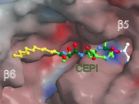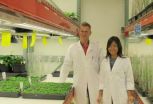(Press-News.org) PHILADELPHIA—Researchers at the Kimmel Cancer Center at Jefferson (KCC) (insert link to "Kimmel Cancer Center at Jefferson" www.kimmelcancercenter.org) have developed potentially game-changing diagnostic and prognostic genetic tests shown to better predict prostate cancer survival outcomes and distinguish clinically-relevant cancers.
The team, led by Richard G. Pestell, M.D., Ph.D., Director of the KCC and the Chair of the Department of Cancer Biology at Thomas Jefferson University, report their preclinical findings from a blinded, retrospective analysis of over 350 patients and mouse study in a recent issue of the journal of Cancer Research.
Using an oncogene-specific prostate cancer molecular signature, the researchers were able to separate out men who died of prostate cancer versus those who lived, and more specifically, identifying men who died on average after 30 months (recurrence free survival). The diagnostic test distinguished patients with clinically relevant prostate cancer from normal prostate in men with elevated prostate-specific antigen (PSA) levels.
The researchers worked with three oncogenes previously associated with poorer outcomes in prostate cancer: c-Myc , Ha-Ras, and v-Src.
The test, the researchers say, is superior to several previously published gene tests and to the Gleason scale, which is a rating given to prostate cancer based upon its microscopic appearance and currently used to help evaluate the prognosis of men with the disease.
Given the diversity of prostate cancer outcomes—some men live two years after diagnosis, others live for more than 20 more years— a new oncogene-specific signature like this could not only help better identify prostate cancer risk but also test targeted therapies—by way of a new prostate cancer cell line.
These studies describe the first isogenic prostate cancer cell lines that metastasize reliably in immune competent mice. Previous studies were in immune deficient mice.
"This oncogene signature shows further value over current biomarkers of prediction and outcomes," said Dr. Pestell. "Such a signature and cell line may also enable the identification of targets for therapies to better treat prostate cancer, which takes the lives of over 27,000 men a year."
In breast cancer, the identification of tumor subsets with various gene signatures has improved clinical care for patients because of targeted therapies.
The work here by the KCC aims to identify gene patterns and subsequent tests in prostate cancer that could serve similar purposes. But to help develop such therapies, model systems that closely resemble human disease are required. To date, there have been several limitations with currently available cell lines.
Although important transplantation experiments have been conducted using human prostate cancer cell lines in immune deficient animals, the immune system plays an important role in prostate cancer onset and progression making it imperative to develop prostate cancer cell lines that can be studied in immune competent animals.
Also, although the transgenic mouse has been an effective model to study the molecular basis of human cancers, the prostate cancer mouse models have long latency and often unpredictable metastasis.
Here, the researchers succeeded in overcoming these issues.
The oncogene-specific prostate cancer molecular signatures were recapitulated in human prostate cancer and validated in distinct populations of patients as a prognostic and diagnostic test.
What's more, the researchers demonstrated how the isogenic prostate cancer cell lines metastasized in immune-competent mice.
"Identification of gene signatures in breast cancer has allowed for a deeper understanding of the disease, and this paper moves us steps closer to being able to follow a similar trajectory with prostate cancer. Today, such an understanding and a formidable testing ground for new therapies is lacking for this disease," Dr. Pestell said. "With this new oncogene-specific prostate cancer molecular signature, we have a valuable prognostic and diagnostic resource that could help change the way we manage and treat prostate cancer."
INFORMATION:
Other researchers in the study include Xiaoming Ju, Adam Ertel, Mathew Casimiro, Zuoren Yu, Hui Meng, Peter A. McCue, Rhonda Walters, and Paolo Fortina.
A link to the full study can be found here: http://cancerres.aacrjournals.org/content/early/2012/11/30/0008-5472.CAN-12-2133.long
Game changing diagnostic & prognostic prostate cancer genetic tests revealed by Jefferson
Researchers at the Kimmel Cancer Center at Jefferson have developed potentially game-changing diagnostic and prognostic genetic tests shown to better predict prostate cancer survival outcomes and distinguish clinically-relevant cancers
2012-12-20
ELSE PRESS RELEASES FROM THIS DATE:
Can observations of a hardy weed help feed the world?
2012-12-20
As the human population increases, so too do the demands and stresses on agriculture. In the January 2013 issue of International Journal of Plant Sciences, Penn State University Waller Professor of Plant Biology Dr. Sarah Assmann explores how the responses to environmental stresses by one small, genetically diverse plant species might illuminate possible approaches to addressing growing human demand for crop products amid decreasing resources.
In the article, Dr. Assmann describes how human population growth presents new challenges to twenty-first-century agriculture, ...
Serendipity points to new potential target and therapy for melanoma
2012-12-20
A University of Colorado Cancer Center study in this month's edition of the Journal of Investigative Dermatology describes a new target and potential treatment for melanoma, the most dangerous form of skin cancer. MicroRNA can decide which genes in a cell's DNA are expressed and which stay silent. Melanoma tends to lack microRNA-26a, which makes the gene SODD go silent.
"It's a double negative," says Yiqun Shellman, PhD, investigator at the CU Cancer Center, associate professor at the CU School of Medicine, and the study's co-senior author. "miR-26a works to stop the ...
Cultural, social factors identified as barriers to minority participation in stem cell donation
2012-12-20
New research examining the role of race and ethnicity in an individual's decision to become a donor for hematopoietic cell transplantation (HCT) identifies several factors associated with varied participation rates in national donor registries across racial/ethnic groups. Results of this first-of-its-kind study are published online today in Blood, the Journal of the American Society of Hematology (ASH).
Hematopoietic cell transplants serve as valuable treatments for a range of blood disorders, as they generate new, healthy blood cells to replace diseased cells. While ...
Poison for cancer cells
2012-12-20
This press release is available in German.
In their quest for new agents, pharmaceutical researchers test millions of substances all over the world. They like using color-forming reactions to identify new molecules. However, in intensively colored solutions or in the case of mixtures with multiple substances these tests fail. As part of his doctoral thesis, Martin Stein, member of staff at the Chair of Biochemistry at the Technische Universitaet Muenchen, developed a testing reaction based on magnetic resonance data. It helps find a specific pharmaceutical molecule ...
Clean air: New paints break down nitrogen oxides
2012-12-20
The Seventies: Smog alert in the Ruhr area, acid rain, dying spruce trees in the Bavarian Forest. In those days, the solution was filter systems for the smokestacks in the Ruhr area. Today, people in the urban areas are suffering from high levels of pollution that is being caused by, among other things, automotive traffic. Particularly undesired: the nitrogen oxides (NOX). In the meantime, the European Union tightened the limit values even further; in many communities they are being exceeded. Michael Hüben of the Fraunhofer Institute for Molecular Biology and Applied Ecology ...
Aldrich Materials Science discovers liquid-free preparation of metal organic frameworks
2012-12-20
St. Louis, MO – December 18, 2012 – Researchers at Aldrich Materials Science, a strategic technology initiative of Sigma-Aldrich Corporation (NASDAQ:SIAL) have discovered an innovative way to design an important class of three-dimensional (3D) hybrid structures, Metal Organic Frameworks (MOFs), under completely liquid-free conditions. High purity MOF products prepared by the liquid-free process may be ideally suited as rare earth containing materials for sensors and detectors, electronic or magnetic materials. The discovery also extends liquid-free preparation techniques ...
Pair of proteins gets brain cells into shape
2012-12-20
This press release is available in German.
The study conducted by Prof. Frank Bradke's team provides indications on brain development and about the causes of diseases of the nervous system. The results have now been published in "Neuron".
Under the microscope, the brain appears as a network of intricate beauty comprising billions of nerve cells (the so-called "neurons") linked together. This network is engaged in a constant process of sharing information. The signals are transmitted from neuron to neuron through fine ramifications of the cell body. However, to acquire ...
University of Alberta research working towards treatment for aortic aneurysms in the abdomen
2012-12-20
A researcher with the Faculty of Medicine & Dentistry and the Mazankowski Alberta Heart Institute is looking closely at a molecule linked to aortic aneurysms in the abdomen, and her findings could lead to a treatment to reduce swelling of the aortic artery, which would be a life-saving treatment.
Zamaneh Kassiri, a professor in the Department of Physiology, and Ratnadeep Basu, a PhD trainee in Kassiri's lab, have been looking at the role of a protein called TIMP3 in the vessels. Their most recent findings, published in The Journal of Biological Chemistry, shows that animal ...
Death of hemlock trees yields new life for hardwood trees, but at what cost to the ecosystem?
2012-12-20
URBANA – Due to the introduction of exotic pests and pathogens, tree species are being eliminated one by one from forest ecosystems. In some cases, scientists can observe immediately how their loss affects the environment, whereas in other cases, creative puzzle solving and analysis reveal unexpected repercussions. In the case of the loss of the hemlock tree, University of Illinois landscape and ecosystem ecologist Jennifer Fraterrigo uncovered a surprising benefit to hardwood species.
Throughout much of the eastern United States, a pest called the hemlock woolly adelgid ...
Discovery may pave way to genetically enhanced biofuel crops
2012-12-20
Best known for its ability to transform simmering pots of sugared fruit into marmalades and jams, pectin is a major constituent of plant cell walls and the middle lamella, the sticky layer that glues neighboring plant cells together. Pectin imparts strength and elasticity to the plant and forms a protective barrier against the environment. Several different kinds of pectic compounds combine to form pectin. The relative proportion of each of these depends on the plant species, location within the plant, and environment. Pectic compounds decorated with β-1,4-galactan ...
LAST 30 PRESS RELEASES:
This new understanding of T cell receptors may improve cancer immunotherapies
A new fossil face sheds light on early migrations of ancient human ancestor
A new immunotherapy approach could work for many types of cancer
A new way to diagnose deadly lung infections and save lives
40 percent of MRI signals do not correspond to actual brain activity
How brain-inspired algorithms could drive down AI energy costs
Gum disease may be linked to plaque buildup in arteries, higher risk of major CVD events
Contrails are a major driver of aviation’s climate impact
Structure of dopamine-releasing neurons relates to the type of circuits they form for smell-processing
Reducing social isolation protects the brain in later life
Keeping the heart healthy increases longevity even after cancer
Young adults commonly mix cannabis with nicotine and tobacco
Comprehensive review illuminates tau protein's dual nature in brain health, disease, and emerging psychiatric connections
Book prepares K-12 leaders for the next public health crisis
Storms in the Southern Ocean mitigates global warming
Seals on the move: Research reveals key data for offshore development and international ecology
Sports injuries sustained during your period might be more severe
World's first successful 2 Tbit/s free-space optical communication using small optical terminals mountable on satellites and HAPS
Can intimate relationships affect your heart? New study says ‘yes’
Scalable and healable gradient textiles for multi‑scenario radiative cooling via bicomponent blow spinning
Research shows informed traders never let a good climate crisis go to waste
Intelligent XGBoost framework enhances asphalt pavement skid resistance assessment
Dual-function biomaterials for postoperative osteosarcoma: Tumor suppression and bone regeneration
New framework reveals where transport emissions concentrate in Singapore
NTP-enhanced lattice oxygen activation in Ce-Co catalysts for low-temperature soot combustion
Synergistic interface engineering in Cu-Zn-Ce catalysts for efficient CO2 hydrogenation to methanol
COVID-19 leaves a lasting mark on the human brain
Scientists use ultrasound to soften and treat cancer tumors without damaging healthy tissue
Community swimming program for Black youth boosts skills, sense of belonging, study finds
Specific depressive symptoms in midlife linked to increased dementia risk
[Press-News.org] Game changing diagnostic & prognostic prostate cancer genetic tests revealed by JeffersonResearchers at the Kimmel Cancer Center at Jefferson have developed potentially game-changing diagnostic and prognostic genetic tests shown to better predict prostate cancer survival outcomes and distinguish clinically-relevant cancers




